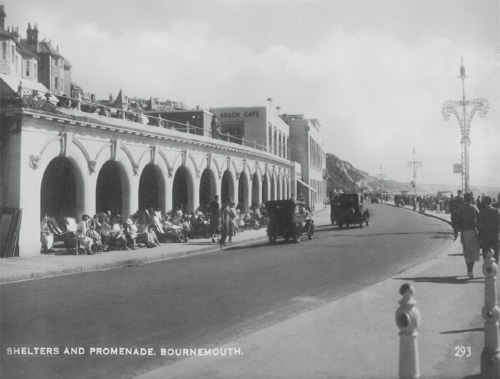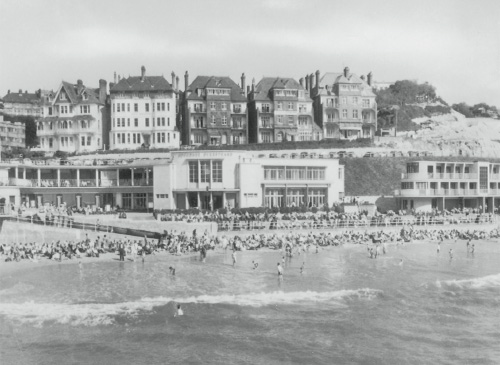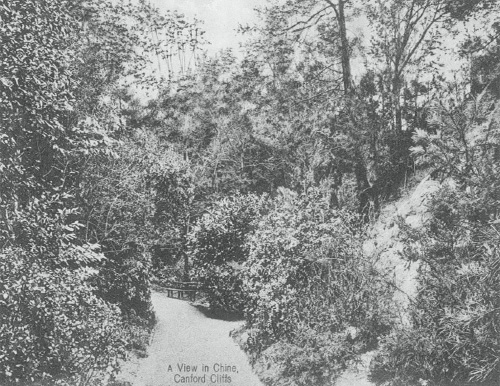Dorset Murders (16 page)


Bournemouth Promenade, 1932
.
Their worst fears were realised when they read in the newspaper the following morning that the body of a woman had been found by retired labourer Charles Nicklen in a field in Tuckton, on the outskirts of Bournemouth. The deceased had not yet been identified, but was wearing a gold watch engraved with the initials âIMW' and had the name âI Wilkins' marked on some of her underclothes. Irene's brother, Noel, immediately contacted the police in Streatham.
Nicklen had been on his regular morning walk at 7.30 a.m. on 23 December when he had spotted some cows taking an unusual interest in an object in a field. His curiosity aroused, Nicklen went for a closer look and found the woman lying on her back, her legs wide apart and her face covered in blood and bruises. After touching the body to make absolutely sure that the woman was dead, Nicklen hurried to a nearby waterworks, from where the police were called.
Officers arrived at Tuckton before 8 a.m., followed shortly by police surgeon Dr Harold Simmons. They found the woman lying on blood-saturated ground, concealed behind a gorse bush. It appeared that she had been attacked on the gravel path that ran outside the field, since the stones were disturbed as if a struggle had taken place there and a trail of blood led between the path and the body. There were traces of blood on the barbed wire fence enclosing the field, and a woman's umbrella, also bloodstained, lay nearby. Just a few yards away in the road was a brown suede hat trimmed with red ribbons, and in the dirt at the side of the road were clear tyre tracks, which police later determined had been made by a vehicle fitted with Dunlop Magnum tyres.
On initial examination by the doctor, the woman was found to have numerous head wounds varying in severity, which had bled profusely. Rigor mortis was present in her arms and legs and her hands were clenched and stained with blood, as if she had fought hard for her life. Simmons theorised that some of the wounds had been caused by a fist, others by a blunt instrument, such as a hammer, which seemed to have had a projection of some kind or a curved end. He estimated that the woman had been dead for anywhere between five and thirty-six hours.
At a later post-mortem examination, Simmons established that the woman had several skull fractures and that pieces of bone had been driven into her brain. The cause of death was given as shock and blood loss due to severe wounds to the head and face. Her stomach contained approximately two ounces of partially digested blood and little else â she had not eaten for some time. Although her skirts had been lifted, exposing her underwear, there was no physical evidence of a sexual assault, but Simmons was unable to say that this had not been attempted. If the victim had not been sexually assaulted, then it was difficult to imagine a motive for her murder, since she had been carrying nothing worth stealing.
As soon as the police heard from the Wilkins family, they learned of the telegram that had been sent from Boscombe post office. On checking at the post office, they found that two similar telegrams had been sent to different recipients in the few days prior to the murder.
The first, sent on 17 December, was in answer to another advertisement in the
Morning Post
. Like the telegram to Irene Wilkins, the words âexpences' and âBournmouth' were mis-spelled. The recipient, Miss Betty Ditmansen of West Hampstead, decided not to follow up on the telegram since she didn't want to work so far away from London. It was probably one of the best decisions she ever made in her life.

View from Boscombe Pier
.
The second telegram had been sent on 20 December to a nursing agency that had advertised its services, again in the
Morning Post
. This telegram requested that a nurse be sent urgently to âBoscombe Grange' and the agency despatched Nurse Burnside in response. On arriving at Bournemouth, the nurse found no car waiting for her as had been promised. She hailed a taxi and was eventually driven to Boscombe Grange in Percy Road, where the occupants professed to have no knowledge of any telegram and no need for the services of a nurse. Having already enquired at numerous nursing homes in the area and several other addresses that included the word Grange, Nurse Burnside was, by now, tired and somewhat confused. The occupants of Boscombe Grange took pity on her and found her a bed for the night and, the following morning, she went to Boscombe post office to try and locate the sender of the telegram.
By an amazing coincidence, Nurse Burnside was actually in the post office at exactly the same time that the man handed over the telegram to be sent to Irene Wilkins. As she tried to unravel the mystery of her telegram, the very person who sent it must have overheard her!
The police were in no doubt that the same person had sent all the telegrams. They questioned the staff at the post office and found one person, counter clerk Alice Waters, who recalled something of the sender. She had been unable to read one of the words on the telegram form, thinking that the word car looked like âear'. She had queried the wording and had been corrected by the sender, who, she recalled, had a particularly gruff, husky voice. Acting on her recollections, the police issued a description of a man that they wanted to speak to in connection with the murder. Age 28â30; 5ft 6in to 5ft 8in in height; dressed in a chauffeur's hat and overcoat, blue in colour; having the appearance of a chauffeur; uneducated speech.'
Having spoken to railway workers and taxi drivers who had been at the station in Bournemouth at time when Irene Wilkins had expected to have been met, they also put out an appeal for the owners of a dark blue six-cylinder Sunbeam with the letter X in the registration plate and a large grey car with black wings and a Middlesex registration plate to come forward. Another car that they were anxious to trace â which may or may not have been the Sunbeam â bore the registration XE 5086, and another had the numbers 7006, but no index letter or letters were known.
Two taxi drivers both claimed to have seen Irene Wilkins at the station but their accounts differed. Mr Webb remembered Irene wearing a light coloured cloak, while Mr Brown recalled it as being dark purple. Neither description matched the clothes that Irene Wilkins had actually been wearing when she set out for Bournemouth, which were described by her mother as a heavy brown coat, brown suede hat, blue woollen jumper, navy blue skirt and black shoes and stockings
Meanwhile, at an inquest into the death of Irene Wilkins held on 27 December, the jury returned a verdict of wilful murder by person or persons unknown.
The first real breakthrough in the investigation came on 31 December when Benjamin Barnley, an unemployed groom, was walking on Canford Cliffs, about eight miles from where Irene's body had been discovered, and spotted a folded woman's nightdress on the ground. When he looked more closely, he found an attaché case, an empty purse and assorted personal possessions concealed under a rhododendron bush. The effects included an envelope containing an Army testimonial for Irene May Wilkins and the telegram she had been sent summoning her to Bournemouth. Realising the significance of his find, Barnley went straight to the police station. The items were damp and stained with mildew and had obviously been there for some time. Surprisingly, Barnley had walked the same path six times a day for the previous nine days and had not previously noticed anything.

Canford Cliffs, 1933
.
On the same day, Superintendent Shadrach Garrett of the Hampshire Police issued a new appeal for information. Accusing the public of apathy, Garrett said that the police had been unable to trace any of Irene Wilkins's movements after she left home. Reported sightings of a woman matching her description seen at Bournemouth station were conflicting and not conclusive. They were interested in details of any cars seen at the station on 22 December and were now also seeking the driver of a two-seater car seen parked with its headlights on near the woods where the attaché case had been found.
It was estimated that between twelve and fifteen cars had been at the station at the crucial time and, so far, only six owners or drivers had come forward. Of particular interest were the large six-cylinder Sunbeam, another large six-cylinder car of unknown manufacture and also some two-seaters. Eventually, the police decided to examine all the cars in the district, asking owners, drivers and chauffeurs to submit their cars for examination. As tyre marks had been found near to where Irene's body had been dumped, they naturally paid particular attention to the tyres. At the same time, the police took the decision to publish a copy of the telegram in the local and national newspapers, in the hope that someone may recognise the handwriting.
One man who was interviewed at the time was Thomas Henry Allaway, a thirty-six-year-old chauffeur employed by a Mr Arthur Sutton, who was then resident at the Carlton Hotel, Bournemouth. Allaway lived with his wife and three-year-old daughter in Haviland Road, Boscombe, and routinely garaged his employer's car at Portman Mews Garage, Boscombe.
Allaway was seen by police on 7 January, and his employer's car, a Mercedes with the registration number LK 7405, was inspected. The car's front tyres were both Dunlop Magnums, while the rear tyres were one Dunlop Magnum and one Michelin. Allaway told the police that the car tyres had not been changed since 22 December.
Nothing about the car excited suspicion and Allaway was able to account for his movements on the evening of 22 December. He was asked to write copies of the decoy telegrams, but his handwriting differed from that on the originals.
The case dragged on unsolved, although the police continued to make exhaustive enquiries, staging a reconstruction and even apparently calling on the services of psychics and mediums. With no further leads, in April 1922, Superintendent Garrett ordered a full review of all the documentation pertaining to the enquiry, which by that time numbered in excess of 20,000 items.
Among the statements revisited were two made by engineer Frank Humphris. Superintendent Garrett had read the first statement, made within forty-eight hours, in which Humphris described alighting from the 4.30 p.m. train at Bournemouth and seeing a woman resembling the description of Irene Wilkins being driven off in a car by a man. Humphris had given a good description of both the man and the car.
On the morning of 4 January, Humphris had again presented himself at the police station to say that he had just seen the same man and car at the station. This time he had the presence of mind to write down the car's make and registration number. It was the Mercedes LK 7405, registered to Allaway's employer.
Allaway was interviewed as a consequence of this statement, but incredibly the evidence linking him and his car to Bournemouth station at the crucial time was misplaced and consequently Garrett didn't see it until the third week in April.
Over the course of the investigations, various pieces of information about Allaway had reached the police. Walter Randall, who garaged his vehicle in the same place as Allaway's, claimed that the Mercedes was not in its usual place at the time of the murder and that Allaway had changed one of the car's tyres on 24 December, just two days later. Allaway's employer's son lived at a place called âBeech Hurst', which was a similar name to the âBeech House' used in the telegram sent to Nurse Burnside. And finally, his employer's sister-in-law lived just a few yards from the spot where Irene's case had been found and, on 23 December, Allaway had driven Mrs Sutton there to take tea, waiting outside in the car for her for more than an hour.